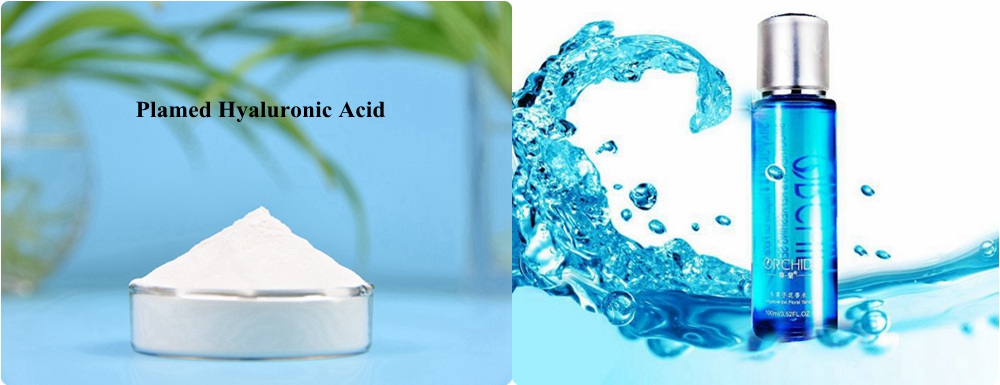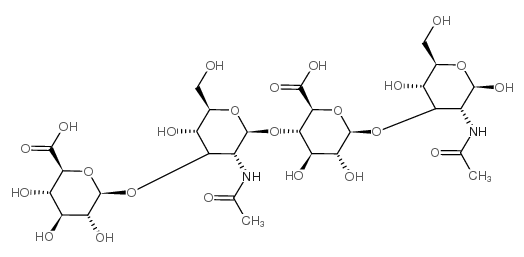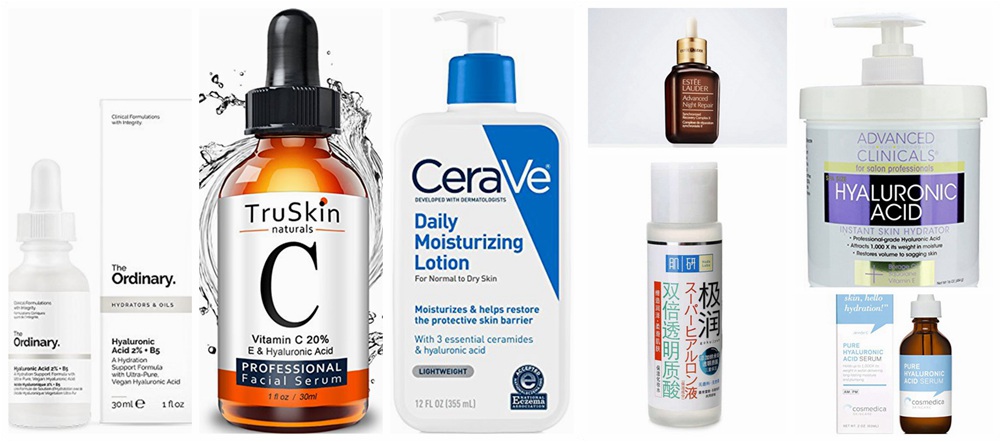1. Sodium Hyaluronate Overview
Hyaluronic Acid (HA), also known as Hyaluronan, is an acidic mucopolysaccharide composed of D-glucuronic disaccharide unit and N-acetylglucosamine. It can be found in intercellular, vitreous body and joint synovial fluid; also it is an important component of skin. Nowadays, HA is obtained by microbiological fermentation, and sold in the form of its sodium salt (Sodium Hyaluronate). There are many functional groups such as hydroxyl group and carboxyl group distributing in the outer layer of Sodium Hyaluronate‘s molecular structure. These groups are able to hydrogen bonds with water molecules, which make it be an extremely strong absorbent. So Sodium Hyaluronate has a great moisturizing effect. As a natural moisturizer, Sodium Hyaluronate is widely used in various cosmetics. It is also named the fourth generation of cosmetic additives or biomimetic cosmetic additives. More importantly, Sodium Hyaluronate is the best cosmetic moisturizing ingredient known in the nature at present.

Chemically speaking, Sodium Hyaluronate is a form of sodium salt of Hyaluronic Acid. From a commercial perspective,
| Product Name | CAS Number | INCI Name | |
| Sodium Hyaluronate | 9067-32-7 | SODIUM HYALURONATE | |
| Molecular Weight | Molecular Formula | Molecular Structure | |
| 776.65g/mol | (C12H21NO11)n |  |
|
| Product ID | Specificcation | Minimal Package | Minimal Order Quantity |
| PMS0301 | ≤1W
1W-10W 10W-40W 50W-130W |
1KG | 1KG |
2. Sodium Hyaluronate Source
There are 3 methods to obtain Sodium Hyaluronate: microbiological fermentation, animal tissue extraction, chemical synthesis. Plamed Sodium Hyaluronate comes from microbiological fermentation. In this way, Sodium Hyaluronate has high purity and good performance-price ratio.
| Method | Technical process | Advantages | Disadvantages |
| Microbiological fermentation | Use Glucose as carbon source fermentation liquid, and ferment in the medium for 48 hours. After fermentation, filter out mycelium and impurities, then obtain Sodium Hyaluronate by alcohol precipitation method. | High purity, raw materials is not restricted, simple operation, low cost. | \
|
| Animal tissue extraction | Use cockscomb or bovine vitreous body as raw material, degrease and dehydrate with acetone or ethanol, soak and filter with distilled water, and then treat with sodium chloride aqueous solution and chloroform solution. After adding trypsin to obtain the mixture, and finally treat with ion exchange agent, then purify to get Hyaluronic Acid. | \ | Low extraction rate, difficulty in source of raw materials, complex separation process, high cost. |
| Chemical synthesis | Use natural enzymes for polymerization reaction, use of polysaccharide polymers to synthesize ” Sodium Hyaluronate oxynitrogen heterocyclopentene derivatives”, then add water to decompose enzyme, get a complex of derivatives and enzyme, remove the enzymes in the 90℃ reaction liquid, then synthesize Sodium Hyaluronate. | Low cost. | Low purity. |
3. Sodium Hyaluronate Manufacturer Specifications
| Product Name | Specification | Color |
| Sodium Hyaluronate | 0.6×106~1.4 x106 DA | White powder |
| ≤0.6×106 DA | ||
| ≥1.4×106 DA |
Sodium Hyaluronate 0.6×106~1.4 x106 DA COA
| Items | Specifications |
| Molecular weight | 0.6×106~1.4 x106 DA |
| Appearance | White powder |
| Glucuronic acid | ≥44% |
| Protein | ≤0.05% |
| pH | 6.0-7.5 |
| Physical Characteristics | |
| Transparency (0.1%solution) | ≥99.0% |
| Moisture | ≤10.0% |
| Ash content | ≤13.0% |
| Heavy Metals | |
| Heavy metals | ≤10ppm |
| Microbiological Tests | |
| Total Plate count | ≤100cfu/g |
| Yeast & mold | ≤100cfu/g |
| Escherichia coli | Negative |
| Staphylococcus | Negative |
| Salmonella | Negative |
Sodium Hyaluronate ≤0.6×106 DA、≥1.4×106 DA COA
| Items | Specifications |
| Molecular weight | ≤0.6×106 DA、≥1.4×106 DA |
| Glucuronic acid | ≥44% |
| Protein | ≤0.05% |
| pH | 6.0-7.5 |
| Appearance | White powder |
| Physical Characteristics | |
| Transparency(0.1%solution) | ≥99.0% |
| Moisture | ≤10.0% |
| Ash Content | ≤20.0% |
| Heavy Metals | |
| Heavy metals | ≤10ppm |
| Microbiological Tests | |
| Total Plate count | ≤100cfu/g |
4. Sodium Hyaluronate Manufacturer Process Flow Chart

5. Sodium Hyaluronate Benefits
- Moisturizing
Sodium Hyaluronate has large molecular volume and the molecular weight usually reaches into the millions. In aqueous solution, its molecules is extremely stretch out, and entangle to form a continuous network structure. Water molecules combine with Sodium Hyaluronate molecules through polar bonds and hydrogen bonds in this network. The combination makes Sodium Hyaluronate like a “molecular sponge” that absorbs and retains much more moisture. When the “molecular sponge” which is full of water is applied to the skin surface, it will form a hydration film. So Sodium Hyaluronate has a moisturizing effect on stratum corneum; and it prevents the skin from being dry and exerts a skin care effect.
- Anti-aging
Studies have found that when Sodium Hyaluronate binds to the cell surface, it blocks the release of some enzymes; it reduces free radicals. Sodium Hyaluronate can mainly restrict several enzymes close to the cell membrane. The enzymes produce free radicals and lipid peroxidation. Then it can reduce the inflow of hydroxyl radicals on the cell membrane surface; and it prevents the destruction of cell structure. Thus Sodium Hyaluronate can exert its anti-wrinkles and anti-aging effects. After properly applying a certain amount of Sodium Hyaluronate to the skin, HA can quickly bind to the cell surface. It can timely transmit the external growth signal to the cell, and then directly promote tissue’s proliferation, reconstruction and repair. Also HA promotes the recovery of ECM function.
- Stable emulsification
Sodium Hyaluronate is a polymer biological component with a straight chain structure. It has a strong water-holding capacity; and it is easy to form a dense water-soluble polymeric network structure in water. Therefore, its aqueous solution can maintain high viscosity and elasticity, and has a thickening effect. Sodium Hyaluronate has good compatibility with emulsifiers and surfactants. When its aqueous solution mixes with oil phase cosmetics ingredients, the texture of cream, emulsion can be fine and uniform. And long-term storage will not be stratified and water-permeable. It indicates that Sodium Hyaluronate can promote and stabilize emulsification.
- Nourishing skin
Sodium Hyaluronate has the dual effects of moisturizing and nourishing skin, which is unmatched by other moisturizers. When apply on skin surface, macromolecular Sodium Hyaluronate can rapidly form a permeable hydrated film on skin surface to soften the cuticle by hydration; thereby it increases the absorption and utilization of stratum corneum for the active substance. At the same time, Sodium Hyaluronate becomes an effective medium for the delivery of active ingredients in cosmetics, due to skin’s matrix structure. Low-molecular-weight Sodium Hyaluronate can directly penetrate into the dermis to dilate capillaries, increase blood microcirculation, and improve intermediate metabolism. Sodium Hyaluronate acts as a trans-dermal delivery for other active or nutrient components in the skin. Thereby Sodium Hyaluronate can improve the physiological condition of the skin; and it provides a superior external environment for the synthesis of dermal collagen and elastin. Thus Sodium Hyaluronate enhances the supply of nutrients and then produces a nourishing skin function.
- Antibacterial and anti-inflammation
It has been reported that low molecular weight Sodium Hyaluronate can inhibit the pathogens growth and pathological reactions of rodents. It has an antibacterial and anti-inflammatory effect. Due to the unique water absorption and moisturizing function of macromolecular Sodium Hyaluronate, when applied to the skin surface, it is easy to form a hydrated film. The film effectively prevents the skin from bacteria and blocks bacteria from invading the skin. Indirectly, Sodium Hyaluronate exerts antibacterial and anti-inflammatory effect. In addition, Sodium Hyaluronate binds to proteins in the skin matrix. It exists as a protein complex in the intercellular space to form a gel. The gel can bind the cells together. Thereby Sodium Hyaluronate protects cells from pathogenic bacteria and prevents infection.
6. Pharmacological Studies of Sodium Hyaluronate in Relation to Cosmetics
| Test Items | Concentration | Result |
| Elimination of free radical DPPH | 1mg/mL | Elimination rate:54.2% |
| Removal rate of hydroxyl radical | 1mg/mL | Elimination rate:63.5% |
| To promote the proliferation of human keratinocytes | 5×10-6 | Promoting rate:138(Blank 100) |
| Prevention of skin moisture loss | 0.25% | Inhibition rate:78.8% |
| Promotion of percutaneous penetration of medicinal ingredients | 2% | Promoting rate:26 % |
| Inhibition of dermatitis caused by phenol | 10 mg/mL | Inhibition rate:39%±1.6% |
| Absorptive humidity at 33% relative humidity | 10% water solution | Moisture absorption rate:108.1%(Blank 100) |
7. Plamed Sodium Hyaluronate Characteristic
- Complete in specifications, which is convenient for customers to choose;
- High purity and good Sodium Hyaluronate price;
- Small molecular weight is easy to be absorbed by skin.
8. Sodium Hyaluronate Application and Reference Dosage
Sodium Hyaluronate is the best natural moisturizing ingredient for high-grade cosmetics. It has good compatibility and can be added to almost any cosmetic product. It is mainly used in moisturizing cosmetics, such as lotion, toner, essence, mask, facial cleanser, and cream; it can also be used in shampoos, conditioners, shower gels, lipsticks, etc.
| Product | Reference Dosage |
| Sodium Hyaluronate | 0.05-0.5% |
Attention:
- Anti-wrinkle and sunscreen cosmetics should choose Sodium Hyaluronate with higher molecular weight, and the dosage should be 0.1% to 0.5%. Facial cleanser, mask and other products mainly use the permeability of Sodium Hyaluronate, so the low molecular weight Sodium Hyaluronate should be selected. The dosage is generally around 0.1%.
- Sodium Hyaluronate added to cosmetics should be compounded with a certain proportion of macromolecular Sodium Hyaluronate, medium molecular Sodium Hyaluronate and small molecule Sodium Hyaluronate, because skin care product containing only a single molecular weight Sodium Hyaluronate has a limited effect. It cannot exert its optimal moisturizing effect.
- Sodium Hyaluronate should not be mixed with benzalkonium chloride, quaternary ammonium salt and other disinfectants into cosmetics, otherwise the product will produce sediment.
Sodium Hyaluronate application cases in major cosmetic brands in the world:
| Country | Brand | Product |
| Japan | Shiseido | “Bh-24” Serum |
| Hada Labo | Hyaluronic Acid Lotion | |
| Korea | Mizon | Hyaluronic Acid 100-Original Skin Energy |
| MJ Skin Care | Hyaluronic Acid Essence Face Skin Mask | |
| USA | Estee Lauder | Advanced Night Repair Essence |
| Revlon | “MOON DROPS R” Moisturizing Series | |
| Maybellin | Moist Lipstick | |
| 180 Cosmetics | Hyaluronic Acid Serum | |
| Cosmedica Skincare | Pure Hyaluronic Acid Serum | |
| TruSkin Naturals | Professional Facial Serum | |
| Timeless Skin Care | The Original Hyaluronic Acid Serum | |
| Tree of Life | Hyaluronic Acid Serum | |
| The Ordinary | Hyaluronic Acid 2% | |
| CeraVe | Daily Moisturizing Lotion | |
| Advanced Clinicals | Anti-Aging Hyaluronic Acid Cream | |
| France | Guerlain | “Hydrabel-La” Lotion |
| LOREAL | Hyaluronic Acid Moisturize Dandruff Shampoo
Hydra Genius |
|
| Cetaphil | Rich Hydrating Night Cream | |
| Germany | Schwarzkopf | Hyaluronic Acid Repair Shampoo with Micro Essence |
| Balea | Hyaluronic Acid Serum | |
| Dermaroller | Hyaluronic Acid Mask | |
| Viscontour | Hyaluronic Acid Moisturizing Serum | |
| Cosart | Hyaluronic Acid Eyes Gel | |
| China | Mask Family | Whitening and Moisturizing Hyaluronic Acid Black Mask |
| KanS | Hyaluronic Acid Hydrating Mask | |
| DaBao | Hydrating and Moisturizing Cream | |
| Missha | Mask | |
| Doctor Li | Hyaluronic Acid Eye Gel, Mask | |
| MG | Moisturizing Hyaluronic Acid Mask | |
| Morita (Taiwan) | Hyaluronic Acid Mask | |
| Meifubao | Hyaluronic Acid Moisturizing Mask | |
| Bovey | Hyaluronic Acid Moisturizing Serum | |
| Beauty Plus | Hyaluronic Acid Serum | |
| PAT’S | Toner | |
| La Fang | Hyaluronic Acid shampoo |

9. Sodium Hyaluronate Reference Formula
Moisturizing sunscreen:
| Ingredient | Content(%) | Ingredient | Content(%) | |
| Water phase | Sodium Hyaluronate | 0.2 | Titanium Dioxide | 5 |
| Water | 59.7 | Methylparaben | 0.2 | |
| Glycerin | 10 | Xanthan Gum | 0.4 | |
| Oil phase | Isostearin Polyether-25 | 1.8 | Isopropyl Palmitate | 5 |
| Polydimethylsiloxane | 1 | Glyceryl Stearate | 2 | |
| Ethylate Methoxycinnamate | 7 | Propyl Hydroxybenzoate | 0.1 | |
| Cetearyl Alcoho | 5 | Benzophenone-3 | 2.5 | |
| Fragrance | 0.1 | |||
Preparation method:
Mix oil phase ingredients and heat to 75℃, mix water phase ingredients and heat to 75℃, then mix the two phases for 30mins (1000 r/min), stir and cool to 50℃; then add fragrance and continue to stir, cool to 35 ℃, finally get the sunscreen.
Massage essential oil:
| Ingredient | Content(ml) | Ingredient | Content(ml) | |
| Group A | Sodium Hyaluronate | 0.4 | Jojoba Oil | Add to 1L |
| Group B | Dryobalanops Aromatica Oil | 20 | Grapefruit Essential Oil | 5 |
| Camellia Oil | 15 | Orange Essential Oil | 3.5 | |
| Sweet Almond Oil | 2 | Chamomile Essential Oil | 5 | |
| Juniper Berry Essential Oil | 2 | |||
Preparation method:
Mix group B ingredients, then add group A ingredients, mix, and get the massage essential oil. (Sodium Hyaluronate used in this product is mixed with macromolecular Sodium Hyaluronate, medium molecular Sodium Hyaluronate and small molecule Sodium Hyaluronate in a proportion of 1:1:1, which overcomes the limitation of single Sodium Hyaluronate in skin care and plays its best effect. Sodium Hyaluronate can not only promote the stability of massage essential oil, and avoid the volatilization of essential oil, but also have a strong moisturizing capacity. Sodium Hyaluronate is an ideal hydrating product.
Anti-allergic toner:
| Ingredient | Content(%) | Ingredient | Content(%) |
| Glycerol | 5.0 | Propylene Glycol | 3.0 |
| Trehalose | 3.0 | Opuntia Streptacantha Stem Extract | 5.0 |
| Diazolidinyl Urea | 0.2 | Deionized Water | Add to 100 |
| Sodium Hyaluronate | 0.1 | Dipotassium Glycyrrhizate | 0.5 |
| Azone | 1.0 | ||
Moisturizing conditioner:
| Ingredient | Content(%) | Ingredient | Content(%) |
| Sodium Hyaluronate | 0.05 | Dehydrated Sorbitol Monooleate | 2.0 |
| Polyethylene | 4.0 | Polyethylene Pyrrolidone Sodium | 0.1 |
| Glyceryl Monostearate | 2.0 | Methylparaben | 0.1 |
| Glycol Monostearate | 2.0 | Fragrance | Appropriate |
| Squalane | 1.0 | Deionized Water | 87.75 |
| HTMAC | 1.0 | ||
Anti-wrinkle gel:
| Ingredient | Content(%) | Ingredient | Content(%) |
| Sodium Hyaluronate | 0.01 | TiO2(10% solid) | 2.0 |
| Ethyl Alcohol | 12.0 | Placental Extract | 0.5 |
| Methyl 4-hydroxybenzoate | 0.1 | Glycerin | 8.0 |
| Deionized Water | Add to 100 | ||
10. Sodium Hyaluronate Safety
- CTFA and EU both specify Sodium Hyaluronate as a raw material for cosmetics;
- The International Catalogue of Chinese Cosmetic Raw Materials Standards in 2010 issued by CAFFCI and On the Announcement of Name List of Cosmetics Raw Material published by CFDA in 2014 both include Sodium Hyaluronate. There are no reports indicating that Sodium Hyaluronate is unsafe for external use.
11. Packing and Storage
Package: Packed in 25kg paper drums with two plastic bags inside.
Storage: Stored in a cool dry place and away from direct sunlight and oxidizing agents.

Plamed focuses on natural cosmetic ingredients for more than 10 years. We have founded four subsidiary companies, which respectively develops different kinds of cosmetic raw material. Plamed is a company whose CEO is designated as the first secretary general of Shaanxi Plant Extraction Association.
As a professional Sodium Hyaluronate manufacturer, Plamed have been constantly upgrading the production process. We firmly believe that good Sodium Hyaluronate and good Sodium Hyaluronate price will help customers make good terminal products and help customers win a lasting and broad market.













